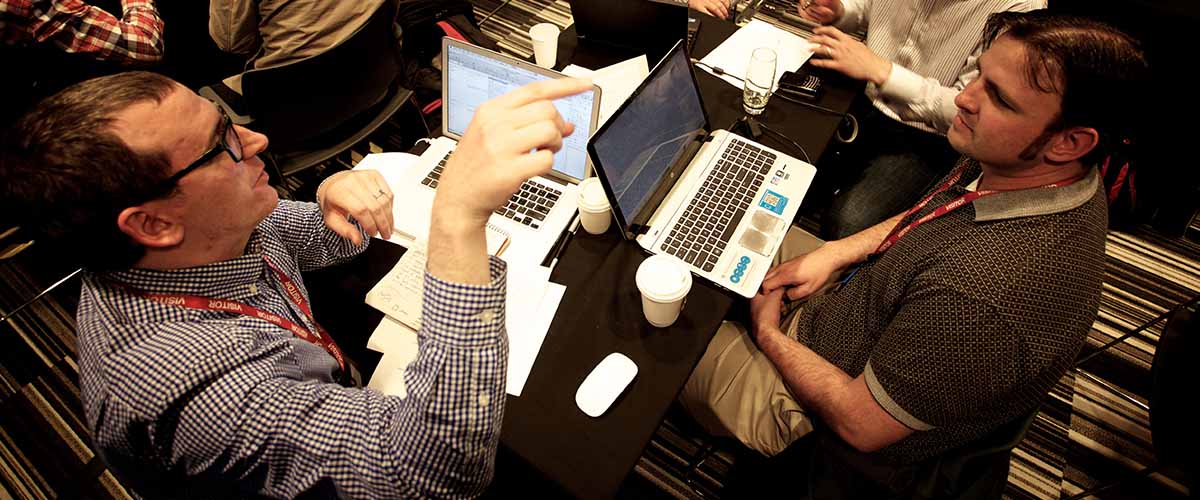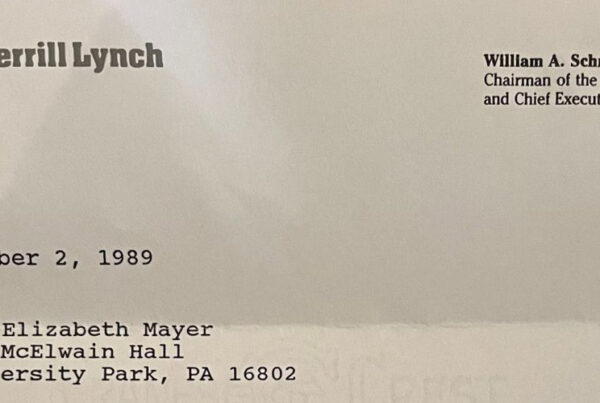
I’ve known Sarah for several years through my membership in the American Marketing Association’s Executive Circle. She has some really great content, ideas, programs, and services all around innovation. In fact, she has it in her DNA. Sarah is a great grandniece of Thomas Alva Edison.
Her first guest blog was, “How Would Thomas Edison Reskill Today’s Workforce?” And like the previous one, her ideas are at the intersection of innovation, leadership, and communication.
From a communication perspective, there are some excellent ideas on improving an organization. One of my favorites is 6. Ensure you are constructing a ‘sponsor spine.’ The metaphor Sponsor Spine just makes sense after you hear it… doesn’t it? Now, “Strategic Externalization” sounds like consulting-speak. And that’s fine, when it makes sense. Leaders are supposed to solve problems. And when the organization is big, that means solving big problems. If a word or phrase like “Strategic Externalization” inspires change, then I’m all for consulting speak. In my humble life, the adage of, “Actions speak louder than words,” has never been wrong.
From Open to Seamless Innovation – 7 Lessons for Growth
I recently attended the 2014 Open Innovation Conference in Baltimore. There was also a deep bench of senior executives from Intel, Amazon, Under Armour, Pfizer, Clorox, and other leading companies. As an official social media voice for the event, I had a unique opportunity to track themes across a content-packed 2-days.
To my surprise, insights emerging from this intense 48-hour event offer benefits to the Open Innovation (OI) community and those of us who primarily navigate the “Closed Innovation” realm as well. In fact, I would estimate that 85% of the content of the OI conference applied equally to folks who champion the innovation process inside their companies and never actually take on an OI role.
Interestingly, many of the OI projects described by the presenters are akin to social innovation initiatives. Unilever, in particular, is endeavoring huge open innovation programs impacting communities as well as nation-wide resource use in Asia. This struck me as a far different “innovation exercise” than one we would have heard about even five years ago. In fact, Unilever is championing the term “seamless innovation.” It is a combination of closed and open innovation that permeates an entire organization and its activities.
As a joyful aside, it was thrilling to note that 10 of the 21 presenters were senior women in their organizations, many with PhDs.
Here are 7 core innovation lessons I took away from the OI conference:
1. Open innovation is increasingly viewed as an area of competitive distinction
Although we often shower accolades on organizations that grow their innovation advantage internally, firms that wrangle success in OI are viewed by peer organizations as leading players in their industries. Rather than indicating that internal strategies are failing, OI success now means that companies are wising up and becoming more agile. OI success offers firms newfound abilities to pivot rapidly into diverse business models, distant geographies, as well as gain access to new target audience groups and technology platforms.
Open innovation…is part of our way of working…We create a unique market position by combining external input with our own innovation skills. – Dr. Sophia Zhou
Increasingly, as voiced by Dr. Sophia Zhou, head of research and Clinical Decision Support Solutions for North America at Philips, “Open innovation is part of our way of working…We create a unique market position by combining external input with our own innovation skills.”
2. “To drive change, you need to offer something”
OI today is really a form of change management. Svetlana Dimovski, manager for Open Innovation with BASF USA, has learned to attract the best people to her OI practice area requires her to offer something in return. Dimovski emphasized actual training around what opening innovation is and how it works has been a key magnetizing point to draw top internal talent.
BASF has assembled an entire cadre of tools embracing licensing opportunities, scouting techniques, leads management, and more. Their proactive efforts in driving increased access to what an OI ecosystem involves has yielded “greater engagement around innovation, more explosiveness of thinking, action, and momentum.” This momentum has begun driving cultural change within the sphere of influence each project wields.
Thinking about my own research on Edison’s world-changing practices, this concept offers parallels to how information traveled from Thomas Edison’s laboratories to his manufacturing partners. When “microcultures of innovation” begin to connect, a dynamic new fabric is formed.
3. OI champions need to stay with their initiatives from funding to proof-of-concept
Many false starts were experienced by OI teams that completed one too many baton hand-offs over the course of their projects. Rather than collaborating and bringing competencies onto their internal team, several failure stories emerged from groups that delegated responsibilities too broadly rather than grooming areas of deep internal knowledge.
This point was emphasized by Barbara Sosnowski, VP of Worldwide R&D at Pfizer. As pharmaceutical companies move further away from the “blockbuster drug’” model to drive revenues, they have now been forced to generate new innovation competencies within their internal teams. Team leaders are thus often behaving differently when they reach out to external partners, actually staying with an initiative all the way from funding to proof-of-concept. This ensures that passion and key insights are not lost as the project progresses.
Sosnowski indicates this new trajectory has enabled Pfizer to have a better view of which projects are at an early stage, mid-stage or in a final stage of product development with key partners. The term given to this new approach is “strategic externalization.”
4. Senior technical contributors are crucial to open innovation success
One question on the minds of every attendee was “How do I create a successful OI team?” Dr. Victoria Scarborough, Director for Open Innovation at Sherwin Williams, hit this issue head-on. Her message resonated across the entire two-day session.
She noted senior technical people must be present on the OI team – particularly in mature industries.
Why? Three reasons:
- They have the respect of others in their field
- They often hold strong business knowledge and not just technical knowledge
- They are more willing to personally accept responsibility for politically navigating the OI process.
Point 3 proved a crucial differentiator between success and failure for OI teams in every industry group. Because open innovation means team exchanges are happening at multiple levels in an organization, OI today is also increasingly a driver of change management flowing from the center upward and outward.
It goes deeper than “just doing projects successfully.” OI now entails reweaving the fabric of the firm one project at a time, with senior technical contributors serving as major catalysts.
5. Open innovation + Closed innovation = Seamless innovation
Abundance is over. – Dr. Shimei Fan
Dr. Shimei Fan, R&D Director of Open Innovation at Unilever, brought home the reality that “Abundance is over.”
She emphasized that with global R&D budgets declining in real dollars over the past 10 years, many R&D teams have been required to shift perspective on where they can influence the business when joining with external partners.
At Unilever, open innovation has meant a shift toward a cradle-to-grave mindset. This impacts revenues and profit, and the entire means of undertaking production in its partnered ecosystem. “We are working toward a marriage of open innovation with closed innovation to create seamless innovation. Our aim is to achieve seamless innovation by 2025.”
Open innovation projects at Unilever have newly directed how the entire organization buys, uses, and distributes products. Unilever is intensely mindful of its water usage, waste stream, and emission of greenhouse gases across the globe.
In undertaking OI initiatives with Dow Chemical, for example, “External R&D” teams have remapped the environmental impact of palm oil groves and palm oil production in Asia. A complete reexamination of how the organization uses clean energy for manufacturing and reduced land usage for actual palm fields has also led to a lower carbon footprint and more favorable environmental impact.
As well, this new mindset has yielded the creation of new metrics, such as examining social implications rather than just raw “cost” or “revenue.” For example, in its partnership with TaTa on developing clean water for rural India, Unilever’s OI effectiveness has included focus on reduced rates of diarrhea, eye infections, and respiratory ailments. Dr. Fan commented, “Using open innovation, we are working to ensure that every child in India can reach the age of 5 and be healthy enough to go to school.” Even 5 years ago, those objectives would likely never have shown up as a form of “innovation ROI.”
6. Ensure you are constructing a ‘sponsor spine.’
Among the many war stories shared at the conference, one in particular stood out.
Luis Solis, President of Imaginatik North America, described failures of projects that did not consciously construct what he termed a “sponsor spine.” A sponsor spine refers to the massive network that links scientists, executives, thinkers, champions, and passionate team members so crucial to the success of an individual innovation effort.
Luis emphasized this sponsor spine must touch all constituencies linked to an OI project team. In fact, counter to our often-insistent desires for efficiency, Luis urged “building redundancy into the system.” Due to mobility of executives and things like budget shifts or team re-designs, holes are likely to develop in sections of the spine over time. The spine itself must always thus remain a focus for the OI project team. “Some teams start in the middle, get their project underway, but never connect it to any other part of the organization. Those teams typically fail.”
In urging executives to organize for innovation, Luis was actually emphasizing a precept Thomas Edison continually reinforced. By organizing for complexity (like connected networks) rather than efficiency (like hierarchies that move in lockstep), the work of innovation can be accomplished more rapidly.
7. “Data allows development of infrastructure in minutes rather than weeks”
Emphasizing the prevalence of public data has transformed the ability of small internal teams to reach out and rapidly build something entirely new, Amazon Web Services guru Frank DiGiammarino pointed to the OI ecosystems created by growth companies like Netflix, OpenTable, and Kiva (as well as – of course – Amazon).
You can scale innovation in a moment’s notice. – Frank DiGiammarino
Here’s the comment Frank made which still rings in my ears: “You can scale innovation in a moment’s notice.”
Today, small teams can act solo or link up with external partners to provide a “big infrastructure” feel to their idea. Citing Onemap.sg as an example (a website whose developers are based in Singapore), Onemap developed a toolkit allowing diverse partners to build collaborative platforms using their public data, and easily bring others into new projects.
Now that’s collaboration! DiGiammarino noted, “We are encouraging all of our clients to bring public data into one frame.”
Although the OI movement has gained considerable traction over the past few years, one big gap remains. Not a single presenter offered a definition of what collaboration is, nor how they consistently exercise collaborative activity in their innovation efforts. I was disappointed to hear “teamwork” and “collaboration” equated as identical animals over and over again. Some real focus is needed on that front to help leaders discern the difference.
There is no gap in the heart, knowledge, and courage of the OI community today. Clearly, heading toward seamless innovation is an important goal that will yield integration of key OI tools with core resources resident within organizations themselves.
Don’t dilute the innovation message. Stay with it to the very end. – Chris Kruger
As seasoned innovator HP Director of R&D Chris Kruger commented, “Don’t dilute the innovation message. Stay with it to the very end.” Thomas Edison couldn’t have said it better.
FURTHER READING ON INNOVATION & LEADERSHIP
Reprinted with permission from Sarah’s Company, PowerPatterns
Photography Source: im-creator



